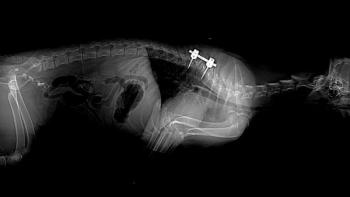
Practical Matters: Don't jump to conclusions in ataxic dogs
A frantic owner brings in a 4-year-old Scottish terrier that cannot use its back legs after a collapse.
A frantic owner brings in a 4-year-old Scottish terrier after it suddenly collapses in the backyard. The owner reports that the dog cannot use its back legs. Your initial thought may be that this dog has a spinal cord disease such as intervertebral disk disease (IVDD). However, this dog turns out to have bilateral cruciate ligament ruptures.
Wanda J. Gordon-Evans, DVM, PhD, DACVS
Dogs with bilateral cruciate disease can have clinical signs similar to those of IVDD. Many owners will describe their dogs as being wobbly before losing the ability to walk. In a case such as this, the dog is refusing to walk because it is in pain, not because it is unable to walk. Careful neurologic and orthopedic examinations will help you distinguish between the diagnoses.
Dogs with bilateral cruciate disease will not have conscious proprioceptive deficits and may choose to walk with a sling or other support. Supporting a portion of the dog's weight is necessary when flipping the paw over to test proprioception. Otherwise, the dog may be in too much pain to right the paw. Stifle pain, effusion, and a cranial drawer sign will be present. Dogs with spinal cord disease generally have conscious proprioceptive deficits even if they are able to ambulate.
Hip dysplasia is another orthopedic disease that occasionally mimics neurologic disease. Severe hip pain, especially in obese dogs, can also make a dog appear ataxic. Dogs with extremely small ranges of motion in their hips may drag their paws in an effort to avoid flexing the hip. Again, thorough orthopedic and neurologic examinations can help you distinguish among these problems. Dogs with both cauda equina syndrome and hip dysplasia exhibit pain on hip extension. However, dogs with hip dysplasia also exhibit pain on hip abduction and sometimes flexion. Dogs with cauda equina syndrome commonly exhibit pain when their tails are lifted or the lumbosacral region is pressed while supporting the dog's weight.
So keep orthopedic problems in mind when evaluating dogs that suddenly collapse or exhibit ataxia. The results of thorough orthopedic and neurologic examinations will point you down the right diagnostic and treatment path.
Editors' note: See Dr. Joan R. Coates' videos on performing a neurologic examination at
Wanda J. Gordon-Evans, DVM, PhD, DACVS
Department of Veterinary Clinical Medicine
College of Veterinary Medicine
University of Illinois
Urbana, IL 61802
Newsletter
From exam room tips to practice management insights, get trusted veterinary news delivered straight to your inbox—subscribe to dvm360.




